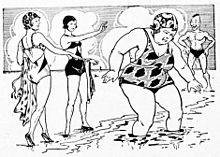Body shaming

Body shaming is the action or inaction of subjecting someone to humiliation and criticism for their bodily features. The scope of body shaming is wide, and includes, although is not limited to
In a study of children's film and books regarding messages about the importance of appearance, media targeted toward children were heavily saturated with messages emphasizing attractiveness as an important part of relationships and interpersonal interaction.
Some forms of body shaming have ancient origins in popular superstition, such as discrimination against people with red hair and stereotypes of people with blonde hair.[4] Forms of discrimination may also differ significantly depending on age group. For example, tall preadolescents are sometimes depicted as awkward and can face derogatory pejorative terms such as "lanky", despite height being a typically valued characteristic among adults.[1]
Sometimes body shaming can extend to a perception that one does not sufficiently display
References
- ^ a b Chen, Hong, and Todd Jackson. "Are cognitive biases associated with body image concerns similar between cultures?." Body Image 2.2 (2005): 177-186.
- S2CID 12491583.
- PMID 12893625.
- ^ Dettmar, Esther Katherine. Revising identification: fairy tales that transform tradition from within. Diss. University of Illinois at Urbana-Champaign, 2016.
- ^ a b Namaste, Ki. "Genderbashing: Sexuality, gender, and the regulation of public space." Environment and Planning D: Society and Space 14.2 (1996): 221-240.
- ^ "'Is that your d***': Bella Thorne body shamed for posing in see-through bra top and boxer". 2 August 2017.
- S2CID 211728899.
- ^ Matheson, Mikayla. "Women's Body Image in the Media: An Analytical Study of Recent Body Image Movements across Media Platforms." (2017).
- S2CID 220282154.
